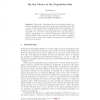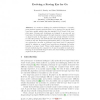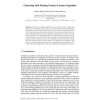GECCO
2004
Springer
15 years 6 months ago
2004
Springer
Abstract. Evolutionary Algorithms (EAs) are population-based randomized optimizers often solving problems quite successfully. Here, the focus is on the possible effects of changin...
GECCO
2004
Springer
15 years 6 months ago
2004
Springer
Abstract. We propose an algorithm for generating all possible generatable r-chunk detectors, which do not cover any elements in self set S. In addition, the algorithm data structur...
102
click to vote
GECCO
2004
Springer
15 years 6 months ago
2004
Springer
Go remains a challenge for artificial intelligence. Currently, most machine learning methods tackle Go by playing on a specific fixed board size, usually smaller than the standa...
103
click to vote
GECCO
2004
Springer
15 years 6 months ago
2004
Springer
Abstract. In this paper we address the problem of finding gene regulatory networks from experimental DNA microarray data. Different approaches to infer the dependencies of gene r...
108
click to vote
GECCO
2004
Springer
15 years 6 months ago
2004
Springer
Recently much research has focused on both the supply chain and reverse logistics network design problem. The rapid progress in computer and network technology and the increasingly...
71
Voted
GECCO
2004
Springer
15 years 6 months ago
2004
Springer
Abstract. We present two important variations on a recently successful bloat control technique, Dynamic Maximum Tree Depth, intended at further improving the results and extending ...
102
click to vote
GECCO
2004
Springer
15 years 6 months ago
2004
Springer
Abstract. Factored Markov Decision Processes is the theoretical framework underlying multi-step Learning Classifier Systems research. This framework is mostly used in the context ...
GECCO
2004
Springer
15 years 6 months ago
2004
Springer
In this paper, a novel multi-objective orthogonal simulated annealing algorithm MOOSA using a generalized Pareto-based scale-independent fitness function and multi-objective intell...
106
Voted
GECCO
2004
Springer
15 years 6 months ago
2004
Springer
GA-based clustering algorithms often employ either simple GA, steady state GA or their variants and fail to consistently and efficiently identify high quality solutions (best known...
110
Voted
GECCO
2004
Springer
15 years 6 months ago
2004
Springer
Aligning multiple DNA or protein sequences is a fundamental step in the analyses of phylogeny, homology and molecular structure. Heuristic algorithms are applied because optimal mu...



